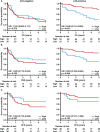TSPO is a potential independent prognostic factor associated with cellular respiration and p16 in head and neck squamous cell carcinoma
- PMID: 38162485
- PMCID: PMC10755888
- DOI: 10.3389/fonc.2023.1298333
TSPO is a potential independent prognostic factor associated with cellular respiration and p16 in head and neck squamous cell carcinoma
Abstract
Background: Treatment resistance and relapse are common problems in head and neck squamous cell carcinoma (HNSCC). Except for p16, no clinically accepted prognostic biomarkers are available for HNSCC. New biomarkers predictive of recurrence and survival are crucial for optimal treatment planning and patient outcome. High translocator protein (TSPO) levels have been associated with poor survival in cancer, but the role of TSPO has not been extensively evaluated in HNSCC.
Materials and methods: TSPO expression was determined in a large population-based tissue microarray cohort including 611 patients with HNSCC and evaluated for survival in several clinicopathological subgroups. A TCGA HNSCC cohort was used to further analyze the role of TSPO in HNSCC.
Results: TSPO expression was downregulated in more aggressive tumors. Low TSPO expression associated with worse 5-year survival and was an independent prognostic factor for disease-specific survival. Subgroup analyses showed that low TSPO expression associated with worse survival particularly in p16-positive oropharyngeal cancer. In silico analyses supported the prognostic role of TSPO. Cellular respiration had the highest significance in pathway analyses for genes expressed positively with TSPO.
Conclusion: Decreased TSPO expression associates with poor prognosis in HNSCC. TSPO is a prognostic biomarker in HNSCC to potentially guide treatment stratification especially in p16-positive oropharyngeal cancer.
Keywords: biomarker; head and neck cancer; immune landscape; oxidative phosphorylation; p16; translocator protein.
Copyright © 2023 Tuominen, Nissi, Kukkula, Routila, Huusko, Leivo, Minn, Irjala, Löyttyniemi, Ventelä, Sundvall and Grönroos.
Conflict of interest statement
The authors declare that the research was conducted in the absence of any commercial or financial relationships that could be construed as a potential conflict of interest.
Figures








References
-
- Machiels JP, René Leemans C, Golusinski W, Grau C, Licitra L, Gregoire V, et al. Squamous cell carcinoma of the oral cavity, larynx, oropharynx and hypopharynx: EHNS-ESMO-ESTRO Clinical Practice Guidelines for diagnosis, treatment and follow-up. Ann Oncol (2020) 31(11):1462–75. doi: 10.1016/j.annonc.2020.07.011 - DOI - PubMed
LinkOut - more resources
Full Text Sources

